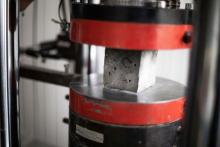
The research team at LSU’s Bert S. Turner Department of Construction Management says they first added the new sugracane SCBA ingredient in 2019.
At the time, early experiments showed that the ductility and strength of the ECC was enhanced using SCBA rather than fine river sand. What was still to be determined was just how much sand replacement with SCBA affected the ECC’s ductility and strength, as well as the role the type of SCBA processing played.
“To date, we have evaluated the use of raw SCBA (this is received SCBA from the sugar mill with minor processing, i.e., drying and sieving) as sand replacement and post-processed SCBA (this is received SCBA post-processed by drying, sieving, burning, and grinding) as cement replacement in ECC materials,” said Gabriel Arce, assistant professor in the Department of Construction Management.
“From our findings, the use of raw SCBA as sand replacement offers great promise, as it produces significant enhancements in the material properties and reduces the cost of ECC. Furthermore, raw SCBA is readily accessible. Regarding the use of post-processed SCBA as cement replacement, we have found that this is not as promising since it does not produce dramatic improvements in material properties, and post-processing of SCBA is a challenge in practical application.”
Arce, who works alongside construction management professor Marwa Hassan on the project, added that they are currently working on a separate project with Texas A&M University regarding Engineered Geopolymer Composites (ECGs). ECGs are geopolymer-based ECCs, meaning that the cement binder is completely replaced by a geopolymer binder.
Arce and Hassan are leading things from the LSU side, while professors Miladin Radovic and Svetlana Sukhishvili lead efforts from Texas A&M’s end.
“The motivation to develop ECGs is that cement is energy-intensive and emission-intensive, producing about 5-7% of all anthropogenic CO2 emissions in the world,” Arce said. “In contrast, geopolymers are eco-friendly and a sustainable alternative since they can be processed from waste materials (e.g., fly ash, slag, etc.) or natural resources (e.g., calcined clays, volcanic rocks, etc.). Its production is also more energy efficient, resulting in lower CO2 emission when compared to ordinary Portland cement binders.”
In terms of their mechanical properties, Arce added that ECCs and ECGs are comparable. However, ECGs are typically lighter in weight, their applications are endless, and because of present costs and their excellent bond characteristics with concrete, they are promising for use in repair of infrastructure.







